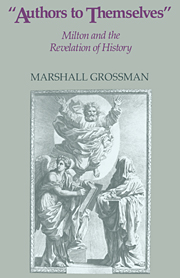4 - “With Answering Looks”
Published online by Cambridge University Press: 23 October 2009
Summary
IF WE DEFINE the narrative of Paradise Lost as the chain of events that leads to “Man's first disobedience” and its consequences, the action of Book IV is slight. Only two events in it are directly related to the fall of man: Satan, overhearing Adam discuss with Eve the single prohibition, obtains the means of their downfall (IV.411–535), and he begins to act upon this new intelligence by inspiring Eve with a dream (IV.800–11). The expression of specific sensibilities rather than the relation of connected actions accounts for the greater part of the book. The lyric interlude in the garden provides a moral context for the ensuing narrative action by further establishing the patterns according to which temporally unfolding events are to be understood. The lyric form itself suggests the prelapsarian experience of human time as pleasant and varied repetition in contradistinction to the more urgent time of irreversible historical events represented by narrative. Satan's entry into Paradise is presented as the intrusion of narrative (as opposed to lyric) time into the world of men and women. The rhetorical projection of Satan's experience and Eve's innocence thus becomes an opportunity for the mimesis of two polar experiences of time.
The principal speeches in Book IV reveal a densely textured development evocative of both these temporal experiences and the relationships between them. The experience of time in the Garden of Eden is projected through and by the situating of a specifically prelapsarian and human subject, distinct from the self-entrapped subject of Satan at the one extreme and the unsituated subject of God at the other.
- Type
- Chapter
- Information
- Authors to ThemselvesMilton and the Revelation of History, pp. 68 - 90Publisher: Cambridge University PressPrint publication year: 1988



